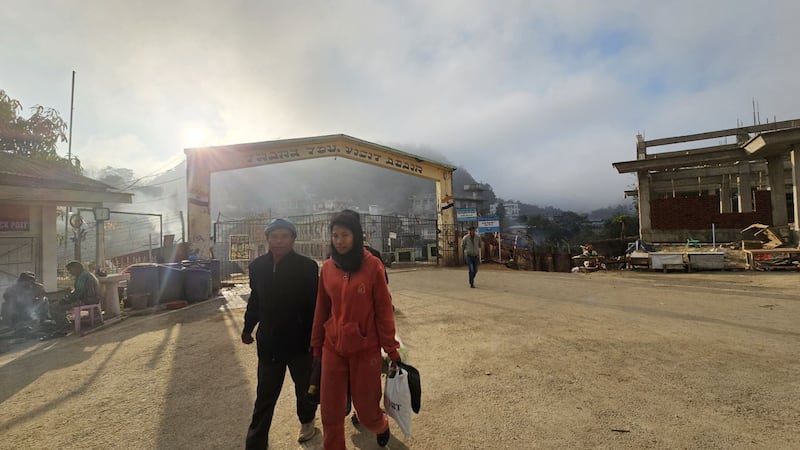[ Read RFA coverage of this topic in BurmeseOpens in new window ]
India is erecting a fence along its border with Myanmar, which residents of Myanmar’s Sagaing region say is cutting off trade routes and driving up the price of goods.
More than 1.6 million people have been displaced by conflict in Myanmar since February 2021, when the military seized power in a coup d’etat, according to the United Nations, with more than 50% of them – an estimated 821,000 people – from the Sagaing region.
Many of the displaced there rely on cross-border trade from India for goods and medicine.
Trade at the Tamu-Moreh border gate connecting India’s Manipur state to Sagaing was suspended in 2021 but area residents have continued to exchange goods through informal routes.
India began construction of its border fence in Manipur state in June 2022 amid an influx of refugees from Myanmar, and Indian Union Government Home Affairs Minister Amit Shah said last week that around 30 km (20 miles) of the barrier have since been completed.
Meanwhile, the junta has blocked roads leading to the checkpoint on the Myanmar side, and ethnic Chin commentator R. Lakher told RFA Burmese that India’s fence will make it difficult for residents in Sagaing to obtain goods and medicine from across the border.
“The price of commodities has already significantly increased [because of the project],” he said. “This border area is relying on India for all its basic commodities and medical treatments. The local populace will surely suffer a lot of difficulties if the border fencing is completed.”
A resident of Sagaing region who, like others interviewed for this report, spoke on condition of anonymity due to security concerns, told RFA that those who need to cross the border are already being forced to do so at unfenced areas, where they must pay higher fees for transportation.
“If the border fencing is completed … residents who have close relatives on both sides will face various difficulties,” he said.
RELATED STORIES
[ Closed borders with India cause food, fuel shortages in western MyanmarOpens in new window ]
[ Food shortages reported in rebel-controlled areas of Myanmar’s Chin stateOpens in new window ]
[ Jailed Myanmar activists in India in danger of deportation: rights groupsOpens in new window ]
India shares a 1,643-km (1,020-mile) border with Myanmar, 398 km (250 miles) of which are located along Manipur state. The Indian government has earmarked US$3.7 billion to build the border fence, which will also cover 520 km (325 miles) in Arunachal Pradesh, 215 km (135 miles) in Nagaland and 510 km (320 miles) in Mizoram.
Another resident of Sagaing told RFA that the border fence will impact people on both sides.
"Not only the people of Myanmar, but also the people of India will suffer difficulties because people from both sides already have a long history of crossing the border,” he said.

Salai Dokhar, the co-founder of aid agency India for Myanmar, said that the Manipur government is urgently erecting the fence because Myanmar’s anti-junta forces have gained control over its border areas.
"As Myanmar rebel forces are in control of border areas close to India, the Indian government will have to deal with them, which I believe it does not want to do,” he said.
Invitation to rebel forces
While the Indian government conducts bilateral negotiations with Myanmar’s junta, it made overtures last week to the country’s rebel forces for the first time since the coup, according to a report by Reuters news agency.
The report said that India extended invitations to Myanmar’s shadow National Unity Government, or NUG, as well as to the Chin National Front, the Kachin Independence Army and the Arakan Army to attend a seminar by the government-funded Indian Council of World Affairs.
A source with knowledge of the issue told RFA that Indian Foreign Minister S. Jaishankar is leading the preparation for the event, the theme of which will be "Constitutionalism and Federalism."
The source said that only the Chin National Front had confirmed their registration to attend the seminar, while the other three groups have yet to respond.
Observers welcomed the move, which they called “pragmatic,” given the junta’s weakening grip on power in Myanmar’s border regions.
“All the Indian borders [with Myanmar] are close to areas under the control of these [anti-junta] forces, and this shows that India has adopted more pragmatic strategies suitable for the situation on the ground," said an ethnic affairs analyst, who also declined to be named due to fear of reprisal.
Attempts by RFA to reach the Indian Embassy in Yangon and the Myanmar Embassy in New Delhi about the border fence went unanswered Friday, as did attempts to contact junta spokesperson Major General Zaw Min Tun for comment on India’s invitation to anti-junta groups.
Indian Foreign Minister S. Jaishankar told his junta counterpart Than Swe in New Delhi on July 26 that his government is open to engaging with all stakeholders in resolving Myanmar's crisis.
Translated by Aung Naing. Edited by Joshua Lipes and Malcolm Foster.
